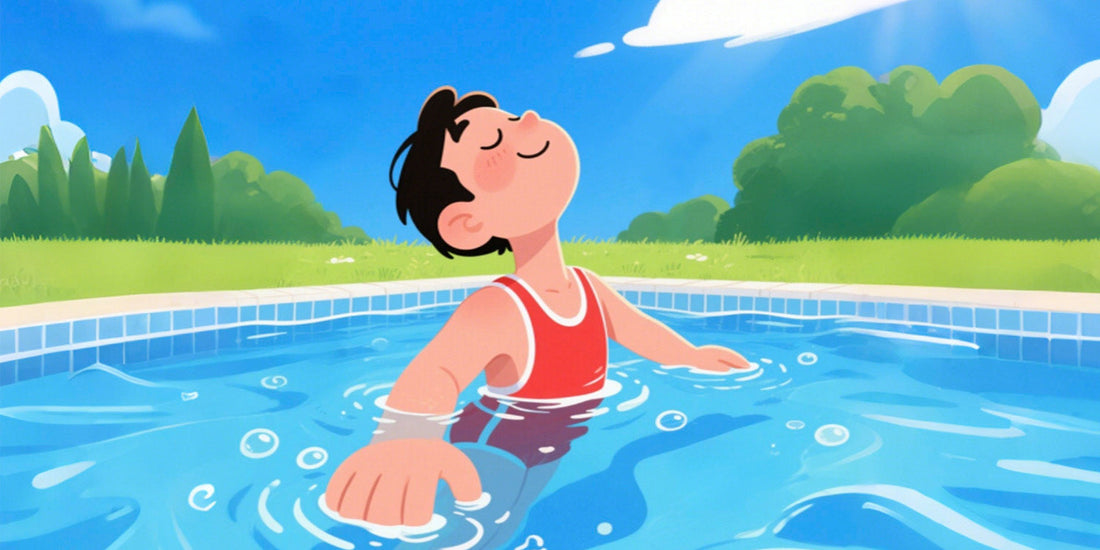
Pool Chemistry Guide
Share
How to Keep Your Pool Water Clear, Safe, and Swim-Ready
Swimming pool is like a giant cup of tea. To keep it tasting right (or in this case, safe and sparkling), you need the right mix of ingredients—too much sugar, and it’s a mess; too little, and it’s just water. Pool chemistry works the same way. You’re aiming for balance.
Here’s a simple guide to the key players in your pool’s chemistry lineup and how they work together.
1. Chlorine: The Sanitizer-in-Chief
Think of chlorine as the superhero of your pool water—it’s the chemical that does the hard work of keeping your water clean and safe. Chlorine's main job is to kill bacteria, viruses, algae, and other microscopic invaders that can make swimmers sick or turn your pool cloudy and green.
It comes in several forms:
- Tablets (usually 3-inch): Long-lasting and easy to use in floaters or skimmers
- Granules: Good for quick boosts or manual adjustments
- Liquid chlorine: Fast-acting, often used for shocking the pool
All of these deliver free chlorine, the form that actually sanitizes your pool.
💡 Fun fact: Chlorine works through a process called oxidation, which is a science-y way of saying it destroys cell walls and disrupts vital processes inside harmful microorganisms—basically, it pops them like tiny water balloons.
But here’s the catch: chlorine only works well when other parts of your pool chemistry—like pH and cyanuric acid—are balanced. If your pH is off, even the right amount of chlorine won’t be effective.
✅ Ideal chlorine level:
1–3 ppm (parts per million) for residential pools
This range ensures effective sanitizing power without irritating skin, eyes, or swimsuits.
Too low? You risk bacteria, cloudy water, and algae.
Too high? It can cause skin and eye irritation, and bleach your pool liners or swimwear.
🔁 Pro tip: Test chlorine levels at least 2–3 times per week, especially in summer or after heavy pool use. If you’re using stabilized chlorine (like trichlor tablets), you may also need to monitor your CYA levels to avoid chlorine lock.
2. pH: The Pool’s Mood
pH is basically your pool’s emotional state — and just like people, water gets grumpy when it’s out of balance. pH measures how acidic or basic your pool water is, on a scale from 0 to 14. A perfectly neutral pH is 7, but your pool actually feels happiest a little above that: between 7.4 and 7.6.
- If the pH drops too low (below 7.2), the water becomes acidic and starts acting out. It can corrode metal parts, sting swimmers’ eyes, and even damage the pool surface. It’s like your pool is throwing a little tantrum.
- If the pH goes too high (above 7.8), the water gets sluggish and moody. You might see cloudy water, scale buildup on tiles, and worse — chlorine stops working as well, which means germs and algae can sneak in.
Keeping your pH balanced is key to making sure everything else works properly. Chlorine is most effective when the pH is in that sweet spot, and your equipment will thank you too — with fewer repairs and longer life.
So test your pH regularly, and if your pool starts acting a little “off,” check its mood first.
3. Alkalinity: The Buffer Zone
Total alkalinity is like your pool’s built-in shock absorber — it keeps your pH levels from going on a rollercoaster ride. You can think of it as a stabilizing friend who talks your pool down when things get out of balance. When alkalinity is in the right range, it prevents sudden spikes or drops in pH, making your water easier to manage and more comfortable to swim in.
If alkalinity is too low, your pH becomes unstable and may fluctuate dramatically, which can cause corrosion of metal parts, itchy skin, and eye irritation. If it’s too high, the water becomes resistant to pH changes, making adjustments feel like trying to turn a cruise ship — slow and frustrating. It can also lead to cloudy water and scaling.
The ideal range is 80–120 ppm (parts per million). To raise low alkalinity, you can add sodium bicarbonate (yep — basically baking soda). If it’s too high, you may need to add muriatic acid to bring it down.
Keeping alkalinity in check gives you a smoother, more predictable pool chemistry experience — and a lot less hassle.
4. Calcium Hardness: Strong Bones for Your Pool
Calcium hardness is all about structure — it measures how much dissolved calcium is in your pool water. Just like your body needs calcium to keep your bones strong, your pool needs it to protect its surfaces and equipment.
If calcium hardness is too low (below 200 ppm), your water turns aggressive. It starts “looking” for calcium anywhere it can get it — including your pool walls, tiles, plaster, and even your heater components. This process, called leaching, can lead to etching, pitting, and surface damage over time. Not only does this look bad, it can be costly to repair.
If calcium levels are too high (above 400 ppm), the opposite problem happens: the water becomes oversaturated and starts depositing excess calcium. That can lead to scale buildup on your tiles, cloudy water, clogged filters, and reduced efficiency in your heater or pump. Your pool starts looking dull, and your equipment might suffer too.
The ideal range for calcium hardness is 200–400 ppm.
- If your levels are too low, you can raise them using calcium chloride.
- If your levels are too high, the solution might involve partially draining and refilling the pool with softer water or using a scale inhibitor product.
Keep in mind that calcium doesn’t evaporate, so levels can slowly climb over time, especially if you top off your pool often with hard water. Testing regularly — especially in areas with hard water or during hot months — helps you stay ahead of the problem.
Keeping calcium in check means a smoother surface, a longer-lasting pool, and fewer headaches down the line.
5. Cyanuric Acid (CYA): Sunscreen for Chlorine
Cyanuric acid, often called CYA, plays a vital protective role in your pool — especially if it’s outside soaking up the sun. Think of CYA as sunscreen for your chlorine. Without it, the ultraviolet (UV) rays from sunlight can break down chlorine incredibly fast — reducing its ability to sanitize and costing you more money in chemicals.
With just the right amount of CYA, chlorine stays in the water longer and works more effectively. That means it can continue doing its job: killing bacteria, preventing algae, and keeping your water clean and safe.
But like any good thing, too much CYA becomes a problem. When levels get too high, chlorine becomes sluggish — it’s still in the water, but it doesn’t react quickly. This can lead to cloudy water, slow sanitizing, and even algae growth, despite having chlorine present. It’s like wrapping your chlorine in too many layers of sunscreen: it’s protected, but it can’t do anything.
The ideal range for CYA in outdoor pools is 30–50 ppm (parts per million).
- Below 30 ppm, your chlorine burns off quickly under sunlight.
- Above 70–100 ppm, chlorine becomes significantly less effective, and you may need to partially drain and dilute your pool water to bring CYA levels back down.
Tip: Many stabilized chlorine products — like trichlor and dichlor tablets — already contain CYA. So even if you’re not directly adding it, your levels may still creep up over time. That’s why regular water testing is so important.
Managing CYA properly helps your chlorine work smarter, not harder — saving you time, money, and frustration in the long run.
6. Shock: The Deep Clean
Even if your pool looks clean, there's a lot going on beneath the surface — sweat, sunscreen, body oils, leaves, and… other things that swim in with people. Over time, these contaminants combine with chlorine to form chloramines, which are less effective at sanitizing and give off that strong “pool smell” most people associate with chlorine (even though it’s actually a sign your pool needs more of it!).
That’s where shocking your pool comes in. To “shock” means to add a super dose of chlorine (or a non-chlorine oxidizer) that breaks down organic waste, kills bacteria, and destroys chloramines. Think of it as hitting the reset button on your water — bringing it back to fresh and clean.
You don’t need to shock every day, but regular treatments go a long way in keeping your water safe and inviting.
Tip: Shock your pool once a week during swim season, or whenever it gets heavy use — like after a pool party, a big storm, or days of intense sun.
- Best time? At night, when the sun can’t burn off the chemicals before they work.
- Safety reminder: Let your pump run for several hours after shocking, and don’t swim again until chlorine levels return to the safe range (typically 1–3 ppm).
Regular shocking helps prevent cloudy water, weird smells, and surprise algae blooms — and it gives your sanitizer a clean slate to work from.
📌 Quick Chemistry Snapshot
| Component | Ideal Range | Why It Matters |
|---|---|---|
| Chlorine | 1–3 ppm | Kills germs and keeps water safe |
| pH | 7.4–7.6 | Keeps chlorine effective, protects gear |
| Alkalinity | 80–120 ppm | Stabilizes pH levels |
| Calcium Hardness | 200–400 ppm | Prevents corrosion or scale |
| CYA | 30–50 ppm (outdoor) | Shields chlorine from UV rays |
🎯 Final Splash
You don’t need a chemistry degree to keep your pool healthy. With just a little routine care and basic understanding, you’ll spend less time testing and guessing—and more time floating and relaxing.
